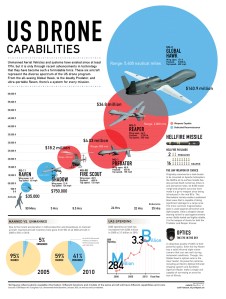The drones are coming! The drones are coming! America’s legally questionable use of Unmanned Aerial Vehicles (sometimes more accurately termed Unmanned Aerial Sensors) abroad has many people worried about the scale and type of future domestic applications. A new bill has been introduced that adresses those fears. If signed into law, it woud severely regulate the purchase and use of drones by law enforcement and other agencies like the FBI.
For the moment, try to forget that big brother may someday have the authority to drive a Hellfire missile through your front door, and just focus on the impressive technology. Here are six drones, selected from an extensive arsenal, that represent the general capabilities of the American drone fleet. Information and quotes about the various UAVs were largely drawn from a publicly available congressional report that is included at the bottom of this article. For those of you who aren’t into sifting through longwinded government documents, we’ve also made and included a handy infographic.
*These figures reflect publicly released information. Different iterations and models of the aircraft will have different capabilities.
1. RQ-4 Global Hawk
“At 44 feet long and weighing 26,750 lbs, Global Hawk is about as large as a medium sized corporate jet. Global Hawk flies at nearly twice the altitude of commercial airliners and can stay aloft at 65,000 feet for as long as 35 hours. It can fly to a target area 5,400 nautical miles away, loiter at 60,000 feet while monitoring an area the size of the state of Illinois for 24 hours, and then return.”
The catch? The Global Hawk program has run severely over budget, and with an after R&D cost of $140.9 million per unit, it may be the most expensive UAV ever built.
2. MQ-1 Predator
When most people think of UAVs, this is probably what comes to mind. First introduced in 1995, and retrofitted with the ability to carry two Hellfire missiles in 2001, the Predator has changed the face of modern warfare. “Through its high-profile use in Iraq and Afghanistan and its multi-mission capabilities, the MQ-1 Predator has become the Department of Defense’s most recognizable UAS. Developed by General Atomics Aeronautical Systems in San Diego, CA, the Predator has helped to define the modern role of UAS with its integrated surveillance payload and armament capabilities.”
For many rural people in places like Yemen and Pakistan, this drone has become the unfortunate face of American diplomacy.
3. MQ-9 Reaper
If the Predator had an angry, steroid addicted older brother, this would be it.
“The Reaper is a medium- to high-altitude, long-endurance Predator optimized for surveillance, target acquisition, and armed engagement. While the Reaper borrows from the overall design of the Predator, the Reaper is 13 feet longer and carries a 16-foot-longer wingspan. It also features a 900hp turboprop engine, which is significantly more powerful than the Predator’s 115 hp engine.These upgrades allow the Reaper to reach a maximum altitude of 50,000 feet, a maximum speed of 225 knots, a maximum endurance of 32 hours, and a maximum range of 2,000 nautical miles.”
What really sets it apart is its ability to carry 16 Hellfire missiles, or a mixture of various ordnance types. There’s a good chance that a lot of so-called Predator strikes were actually carried out by a Reaper.
4. RQ-7 Shadow
The Shadow is a brigade level military reconnaissance asset, and has seen a lot of use in both Afghanistan and Iraq. Maybe the most interesting thing about it is its slingshot launching platform, which is demonstrated in the video above.
“The Shadow is 11 feet long with a wingspan of 13 feet. It has a range of 68 nautical miles, a distance picked to match typical Army brigade operations, and average flight duration of five hours. Although the Shadow can reach a maximum altitude of 14,000 feet, its optimum level is 8,000 feet.”
5. MQ-8 Firescout
Originally designed by the Navy as a surveillance helicopter, someone eventually found the good sense to strap rockets to it.
“With a basic 127-pound payload, the Fire Scout can stay aloft for up to 9.5hours; with the full-capacity sensor payload, endurance diminishes to roughly 6 hours. Fire Scout possesses autonomous flight capabilities. The surveillance payload consists of a laser designator and range finder, an IR camera and a multi-color EO camera, which when adjusted with specific filters could provide mine-detection capabilities. Fire Scout also currently possesses line-of-sight communication data links. Initial tests of an armed Fire Scout were conducted in 2005.”
6. RQ-11 Raven
“The Raven provides Army and SOCOM personnel with ‘over-the-hill’ reconnaissance, sniper spotting, and surveillance scouting of intended convoy routes. The electric motor initiates flight once hand-launched by a running-start from the ground operator. The vehicle is powered by an electric battery that needs to be recharged after 90 minutes, but deployed soldiers are equipped with four auxiliary batteries that can be easily charged using the 28 volt DC outlet in a Humvee. The vehicle lands via a controlled crash in which the camera separates from the body, which is composed of Kevlar plating for extra protection.”
The Raven is small, relatively cheap ($35K), and has a low learning curve. Of all the drones on the list, this one seems the most likely to end up being deployed domestically. Though, as the video above demonstrates, launching it is something of an art.
The promised report.
Follow Dillon Head on Twitter.

